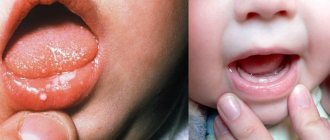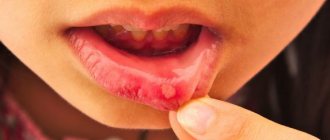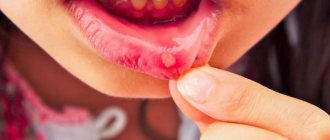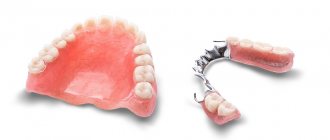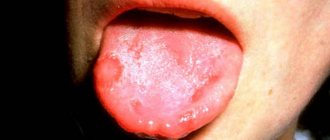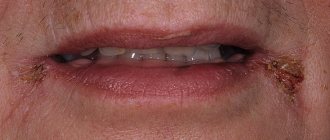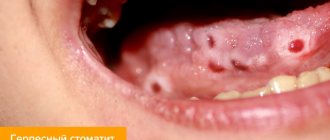Causes of stomatitis
The imperfection of local and general defenses of the child’s body makes the mucous membranes of the oral cavity vulnerable to adverse factors. And the healthy curiosity characteristic of every child has made stomatitis one of the most common diseases among children. Sometimes, for the development of an illness, it is enough to taste any less than sterile object. The main causes of the disease include the following:
- insufficiently good oral hygiene;
- minor injuries - cheek biting, scratch, etc.;
- burns, including chemical burns;
- exposure to pathogens from unwashed hands or dirty toys.
Dentists focus on stomatitis associated with biting the inside of the cheek.
This is often associated with recent dental treatment under local anesthesia. For some time after the procedure, there is reduced sensitivity in the area of the lip or cheek, so you need to eat food after treatment very carefully and only after you have waited for the recommended period of time - usually from 1 to 2 hours. The likelihood of developing stomatitis for these reasons increases after infectious diseases, previous interventions, hypothermia and other factors that contribute to a decrease in protective forces.
Treatment of herpetic stomatitis
Therapy includes the local application of gels with an anesthetic effect, which include lidocaine or articaine (they should be generously lubricated in the mouth).
All kinds of analgesics are prescribed internally, such as ketorol, and, of course, antivirals: Zovirax or acyclovir. Among anti-inflammatory drugs, it is better to choose Cholisal or Metrogyl gel.
Recurrent chronic herpes
In the absence of proper treatment, acute stomatitis becomes chronic - recurrent herpes. The systematic manifestation of single or multiple rashes on the lips, in the mouth area - on the mucous membrane of the eyes, on the palate, genitals and wings of the nose cannot be ruled out.
The appearance of herpetic type rashes is accompanied by a burning sensation. Such a blistering rash subsequently forms merged erosions.
While eating, patients complain of pain and discomfort in the mouth.
The main feature of herpes infection is the likelihood of lifelong infection with the virus.
Types of stomatitis
The treatment regimen for stomatitis in children is based on the type of disease. There are several types of stomatitis:
- bacterial;
- viral, including herpes;
- fungal;
- aphthous;
- angular;
- allergic;
- traumatic.
All types of stomatitis occur in children, but the most common among children under 3 years of age are aphthous, candidal, herpetic and allergic. An increase in the incidence of traumatic stomatitis is usually associated with a period of active growth of primary teeth.
It is important to understand that in some cases, stomatitis is combined with other diseases with similar symptoms and is the first sign of more serious diseases. For example, with cheilitis - inflammation of the mucous membrane and red border of the lips, food allergies, etc.
Acute herpetic stomatitis
As already mentioned, the disease is caused by a virus. Both adults and children are at risk.
So, what is this disease?
The main symptoms of herpetic stomatitis are inflammation of the mucous membrane and aphthae (shallow ulcers and erosions) of the oral cavity.
The disease is highly contagious and can spread quickly to people who have never been infected with the herpes simplex virus.
In most cases, children under three years of age are susceptible to stomatitis, and less often, adolescents and young people.
Initially, there are complaints of deterioration in health with an increase in body temperature from 38°C. As a result of the examination, a slight increase in the cervical and jaw lymph nodes is revealed.
The gums become swollen and red, and small blisters appear filled with clear liquid. The bubbles “burst”, which leads to the appearance of erosions. Aphthae form within 3-5 days.
Patients complain of a feeling of discomfort, burning and itching while chewing food. To ensure that the patient’s condition does not worsen, treatment should be started on time. If the correct therapy is prescribed, the patient will fully recover within 10 days.
If treatment is not followed, then over time, the number of erosions increases, which contributes to the deterioration of the patient’s condition and an increase in body temperature to 39-40.5 ° C.
Herpetic stomatitis manifests itself in mild, moderate and severe stages.
The mild form presents with weakness, malaise and nausea. Temperature is within normal limits. There are a couple of small bubbles in the mouth. The mucous membrane heals quickly.
The moderate form of herpetic stomatitis in patients is manifested by malaise and nausea. Body temperature reaches 38°C. There are a large number of rashes in the mouth.
Nausea, diarrhea and vomiting are the main symptoms of this disease in severe form. Temperature 38.5 - 40°C. There are multiple lesions in the mouth. The presence of all signs of an infectious disease.
To accurately confirm the diagnosis, the dentist prescribes a general blood test and, if necessary, other laboratory tests.
Symptoms
Common symptoms of stomatitis are pain, burning, swelling of the mucous membrane and redness, and bad breath. Salivation also changes - it can be excessive or insufficient, with dry mouth. In some cases, there may be an increase in temperature and enlargement of the submandibular lymph nodes.
The types of stomatitis in children and treatment methods differ, as do the specific manifestations. For example, with aphthous stomatitis, only one large ulceration may appear, but with viral stomatitis, inflammation almost always takes the form of numerous elements or a rash merging into one focus.
Candidal stomatitis is characterized by the formation of a white or yellowish cheesy coating. It is easier to recognize traumatic stomatitis because it is preceded by damage or the source of injury is nearby - a chipped tooth or a rough filling.
Diagnostic features
A dentist can detect stomatitis during the first visual examination. But in controversial cases, laboratory tests may be required. Thus, bacterial inflammation may require identification of the causative agent of the disease and its sensitivity to antibiotics. A scraping and/or virological study will help determine the cause of the disease and prescribe appropriate treatment.
If a combination of several ailments with a similar picture is suspected, as well as if the child’s general well-being deteriorates, laboratory tests of blood and urine and consultations with other specialists may be prescribed.
Sometimes stomatitis can be the first manifestation of systemic diseases, general somatic pathology, for example, diabetes mellitus or malignant neoplasms. Therefore, a timely visit to the doctor is extremely important.
Features of treatment
As is often the case with diseases that are at the intersection of several areas of medicine, inflammatory lesions of the oral mucosa are one of the least studied areas of dentistry. Therefore, several specialists can be involved in the treatment of stomatitis in children in the mouth: pediatrician, dentist, dermatologist, immunologist-allergist, otolaryngologist, etc. This is especially convenient when you go to a multidisciplinary clinic.
Self-medication of stomatitis is unacceptable, and although it is now easy to find ready-made treatment regimens and folk recipes, it is important not to experiment with the baby’s health.
Conservative treatment is mainly used, which involves treating the underlying cause of the disease. Your doctor may prescribe the following medications:
- antibacterial drugs (systemic and local in the form of ointments): for bacterial inflammation;
- antiviral agents for herpes and other types of viral stomatitis;
- antifungal drugs for fungal diseases;
- antihistamines - both for allergic origin of stomatitis, and as part of complex therapy to reduce swelling and itching;
- symptomatic drugs - anti-inflammatory, analgesic, antipyretic.
Treatment of candidal stomatitis in infants should be carried out with caution. At the same time, it is important to pay attention to your health; sometimes the cause of such a disease can be insufficient breast hygiene during lactation.
Often, only local remedies are sufficient, but make sure that the entire oral cavity is treated with the rinse - inflammatory agents can be found on the entire surface of the mucous membranes. Healing applications can be used to a limited extent, only on areas of inflammation.
Treatment of stomatitis of any kind in children involves strict adherence to a diet. The diet should be gentle, it is important to avoid salty, spicy, sour foods and drinks, serve the child warm meals, and limit the consumption of sweets.
If traumatic stomatitis occurs, the doctor will prescribe medications to speed up healing. However, it is very important to prevent re-injury. If it was caused by sharp edges of a tooth or filling, this cause should be eliminated. The doctor will suggest grinding off the filling or replacing it, and will also choose the appropriate option for restoring the shape of the crown in case of chips and cracks.
Causes
The causes of stomatitis in the mouth in adults are of the following types:
- Due to non-compliance with the rules of oral hygiene or improper care of it - rotting of food waste residues in damaged teeth or in gaps with an abnormal structure of the dentition, mechanical impact on the epithelium with a hard brush or rapid movements and strong pressure while brushing the teeth.
- Due to sudden and systematic changes in temperature in the oral cavity.
- Chemical exposure - brushing teeth with toothpastes that contain sodium lauryl sulfate or contain a lot of fluoride; sharp contrast between alkaline and acidic foods. For example, eat boiled meat with a sour apple or fresh wild berries after flour.
- Increased acidity in the mouth;
- Infectious agents: bacteria – cocci; viruses – herpes, ARVI, influenza; pathogenic microflora in the gastrointestinal tract - dysbacteriosis (not so much the microorganisms themselves, but putrefactive and or inflammatory processes due to their vital activity).
- Non-infectious pathogens - pneumococci, fungi except candida. Candida is classified as both infectious and non-infectious, depending on the quantity and location.
- Pathology with concomitant diseases: with diabetes, as a complication of periodontitis, other diseases whose symptoms are inflammatory processes in the body.
Immune nature:
- Autoimmune diseases - when antibodies attack healthy cells;
- Arthritis;
- HIV - in late stages or during exacerbations, or during manifestations of other diseases due to reduced immunity by the immunodeficiency virus.
- Taking medications or folk remedies that interfere with salivation or failure to replenish the body with fluid in a timely manner after taking them.
Often, stomatitis in adults occurs from a high temperature: 39.5 or higher, which lasts 5 days or more. After the temperature normalizes or drops to subfebrile levels, the disease goes away in 3-5 days, and in case of reduced immunity - 7-10 days.
Prevention of stomatitis
You can reduce the risk of developing stomatitis using the following recommendations:
- regular washing of toys, bottles, pacifiers, breast hygiene if the baby is breastfed;
- general strengthening activities: walks, wet cleaning, a balanced diet, moderate hardening, adherence to a daily routine;
- fighting bad habits of biting nails, pencils, etc.;
- regular dental examinations and timely interventions in case of dental injuries.
The dentists of the Family Doctor clinic treat and prevent stomatitis in children.
Advanced equipment allows us to quickly and accurately assess the condition of the oral cavity and perform the necessary studies in a short time. We practice modern approaches to the treatment of inflammatory diseases of the oral cavity and adhere to an individual approach to each small patient. Consultations with a pediatric dentist are available by appointment. To make an appointment, call the single contact center or fill out a special online appointment form with a pediatric dentist on the website, or you can also visit the clinic’s reception in person.

